tow Peugeot 301 2017 Owner's Manual
[x] Cancel search | Manufacturer: PEUGEOT, Model Year: 2017, Model line: 301, Model: Peugeot 301 2017Pages: 306, PDF Size: 9.87 MB
Page 5 of 306
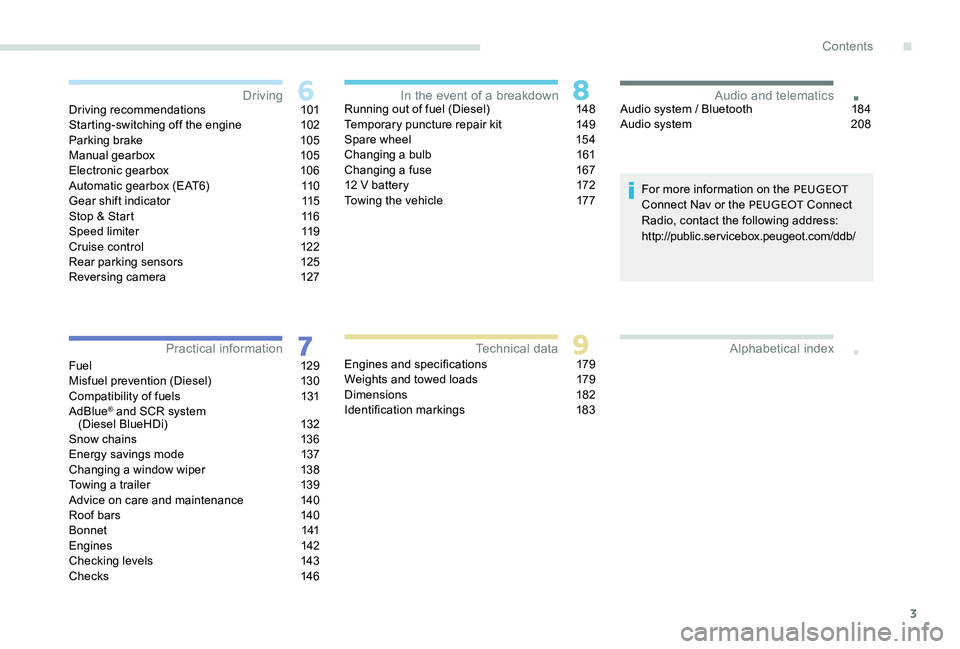
3
.
.Driving recommendations 101
Starting-switching off the engine 1 02
Parking brake
1
05
Manual gearbox
1
05
Electronic gearbox
1
06
Automatic gearbox (EAT6)
1
10
Gear shift indicator
1
15
Stop & Start
1
16
Speed limiter
1
19
Cruise control
1
22
Rear parking sensors
1
25
Reversing camera
1
27
Fuel
129
Misfuel prevention (Diesel)
1
30
Compatibility of fuels
1
31
AdBlue
® and SCR system
(Diesel BlueHDi) 1 32
Snow chains
1
36
Energy savings mode
1
37
Changing a window wiper
1
38
Towing a trailer
1
39
Advice on care and maintenance
1
40
Roof bars
1
40
B o n n e t
1
41
Engines
1
42
Checking levels
1
43
Checks
146Running out of fuel (Diesel)
1
48
Temporary puncture repair kit
1
49
Spare wheel
1
54
Changing a bulb
1
61
Changing a fuse
1
67
12 V battery
1
72
Towing the vehicle
1
77
Engines and specifications
1
79
Weights and towed loads
1
79
Dimensions
182
Identification markings 1 83Audio system / Bluetooth
1
84
Audio system
2
08
For more information on the PEUGEOT
Connect Nav or the PEUGEOT Connect
Radio, contact the following address:
http://public.servicebox.peugeot.com/ddb/
Driving
Practical information In the event of a breakdown
Technical data Audio and telematics
Alphabetical index
.
Contents
Page 11 of 306
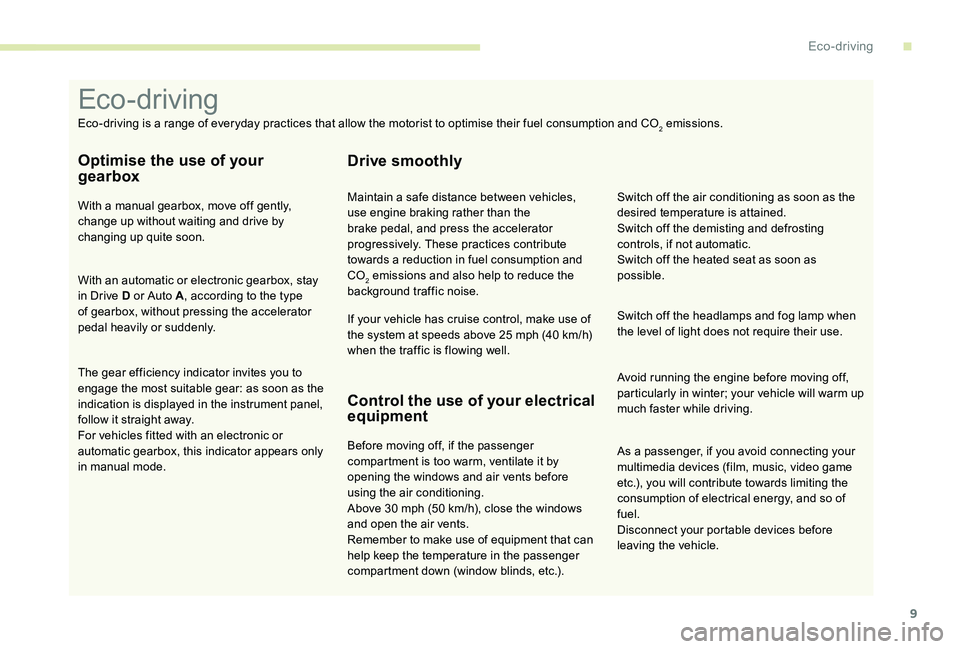
9
As a passenger, if you avoid connecting your
multimedia devices (film, music, video game
etc.), you will contribute towards limiting the
consumption of electrical energy, and so of
fuel.
Disconnect your portable devices before
leaving the vehicle.
Eco-driving
Eco-driving is a range of everyday practices that allow the motorist to optimise their fuel consumption and CO2 emissions.
Optimise the use of your
gearbox
With a manual gearbox, move off gently,
change up without waiting and drive by
changing up quite soon.
With an automatic or electronic gearbox, stay
in Drive D or Auto A, according to the type
of gearbox, without pressing the accelerator
pedal heavily or suddenly.
The gear efficiency indicator invites you to
engage the most suitable gear: as soon as the
indication is displayed in the instrument panel,
follow it straight away.
For vehicles fitted with an electronic or
automatic gearbox, this indicator appears only
in manual mode.
Drive smoothly
Maintain a safe distance between vehicles,
use engine braking rather than the
brake pedal, and press the accelerator
progressively. These practices contribute
towards a reduction in fuel consumption and
CO
2 emissions and also help to reduce the
background traffic noise.
If your vehicle has cruise control, make use of
the system at speeds above 25 mph (40 km/h)
when the traffic is flowing well.
Control the use of your electrical
equipment
Before moving off, if the passenger
compartment is too warm, ventilate it by
opening the windows and air vents before
using the air conditioning.
Above 30 mph (50 km/h), close the windows
and open the air vents.
Remember to make use of equipment that can
help keep the temperature in the passenger
compartment down (window blinds, etc.). Switch off the headlamps and fog lamp when
the level of light does not require their use.
Avoid running the engine before moving off,
particularly in winter; your vehicle will warm up
much faster while driving. Switch off the air conditioning as soon as the
desired temperature is attained.
Switch off the demisting and defrosting
controls, if not automatic.
Switch off the heated seat as soon as
possible.
.
Eco-driving
Page 25 of 306
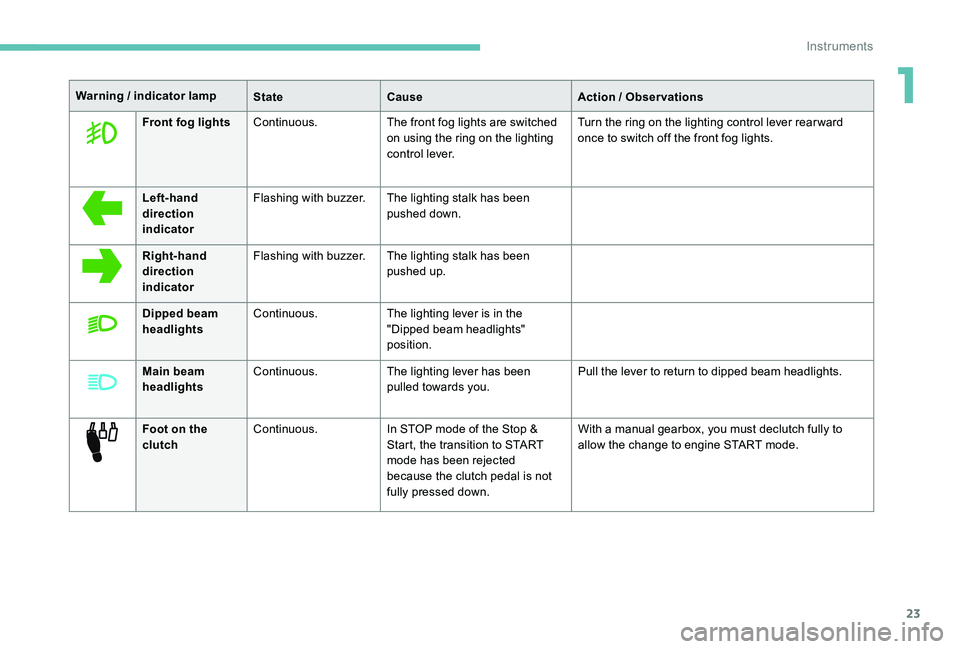
23
Warning / indicator lampStateCause Action / Observations
Front fog lights Continuous. The front fog lights are switched
on using the ring on the lighting
control lever. Turn the ring on the lighting control lever rear ward
once to switch off the front fog lights.
Left-hand
direction
indicator Flashing with buzzer.
The lighting stalk has been
pushed down.
Right-hand
direction
indicator Flashing with buzzer.
The lighting stalk has been
pushed up.
Dipped beam
headlights Continuous.
The lighting lever is in the
"Dipped beam headlights"
position.
Main beam
headlights Continuous.
The lighting lever has been
pulled towards you. Pull the lever to return to dipped beam headlights.
Foot on the
clutch Continuous.
In STOP mode of the Stop &
Start, the transition to START
mode has been rejected
because the clutch pedal is not
fully pressed down. With a manual gearbox, you must declutch fully to
allow the change to engine START mode.
1
Instruments
Page 38 of 306
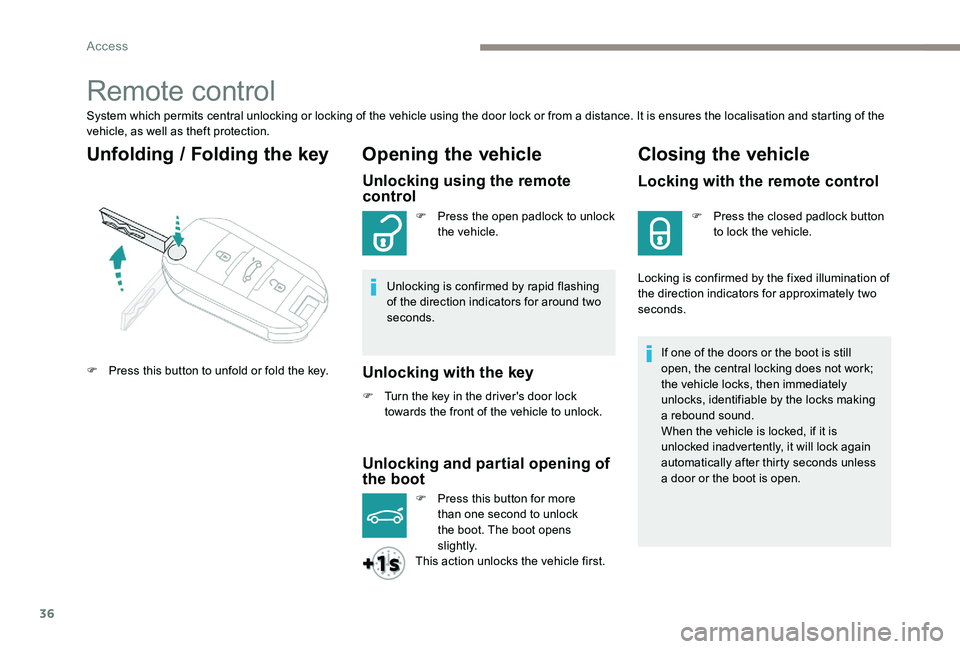
36
Remote control
System which permits central unlocking or locking of the vehicle using the door lock or from a distance. It is ensures the localisation and starting of the
vehicle, as well as theft protection.
Unfolding / Folding the key Opening the vehicle
Unlocking using the remote
control
F Press the open padlock to unlock the vehicle.
Unlocking is confirmed by rapid flashing
of the direction indicators for around two
seconds.
Unlocking with the key
F Turn the key in the driver's door lock towards the front of the vehicle to unlock.
Unlocking and partial opening of
the boot
F Press this button for more than one second to unlock
the boot. The boot opens
s li g ht l y.
This action unlocks the vehicle first.
Closing the vehicle
Locking with the remote control
F Press the closed padlock button to lock the vehicle.
If one of the doors or the boot is still
open, the central locking does not work;
the vehicle locks, then immediately
unlocks, identifiable by the locks making
a rebound sound.
When the vehicle is locked, if it is
unlocked inadvertently, it will lock again
automatically after thirty seconds unless
a door or the boot is open.
Locking is confirmed by the fixed illumination of
the direction indicators for approximately two
seconds.
F
P
ress this button to unfold or fold the key.
Access
Page 39 of 306
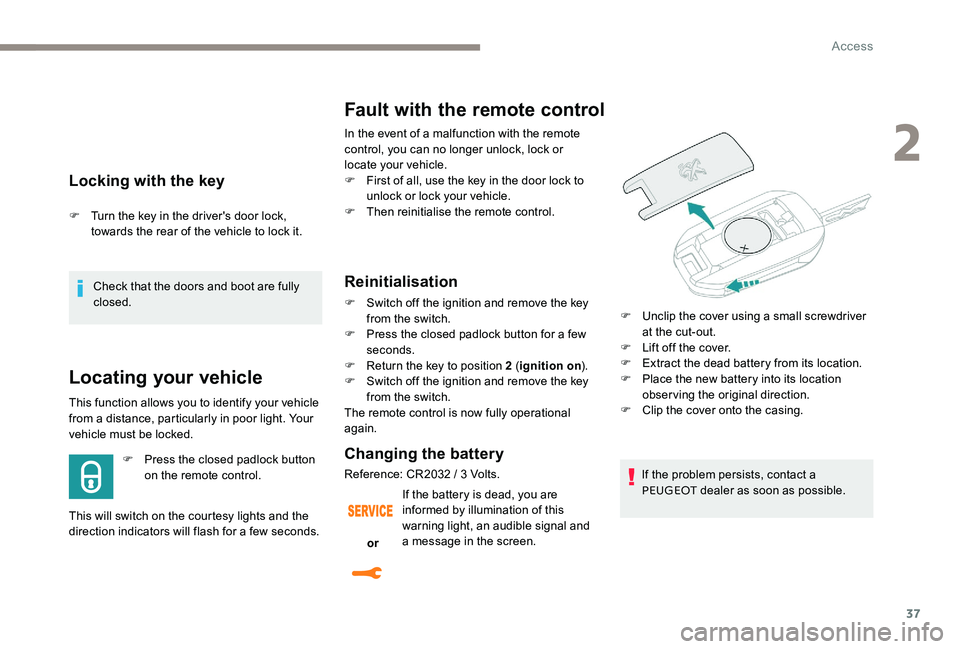
37
Locking with the key
F Turn the key in the driver's door lock, towards the rear of the vehicle to lock it.
Check that the doors and boot are fully
closed.
Locating your vehicle
This function allows you to identify your vehicle
from a distance, particularly in poor light. Your
vehicle must be locked. F
P
ress the closed padlock button
on the remote control.
This will switch on the courtesy lights and the
direction indicators will flash for a few seconds.
Fault with the remote control
In the event of a malfunction with the remote
control, you can no longer unlock, lock or
locate your vehicle.
F
F
irst of all, use the key in the door lock to
unlock or lock your vehicle.
F
T
hen reinitialise the remote control.
Reinitialisation
F Switch off the ignition and remove the key from the switch.
F
P
ress the closed padlock button for a few
seconds.
F
R
eturn the key to position 2 ( ignition on).
F
S
witch off the ignition and remove the key
from the switch.
The remote control is now fully operational
again.
Changing the battery
Reference: CR2032 / 3 Volts. If the problem persists, contact a
PEUGEOT dealer as soon as possible.
or If the battery is dead, you are
informed by illumination of this
warning light, an audible signal and
a message in the screen. F
U
nclip the cover using a small screwdriver
at the cut-out.
F
L
ift off the cover.
F
E
xtract the dead battery from its location.
F
P
lace the new battery into its location
observing the original direction.
F
C
lip the cover onto the casing.
2
Access
Page 44 of 306
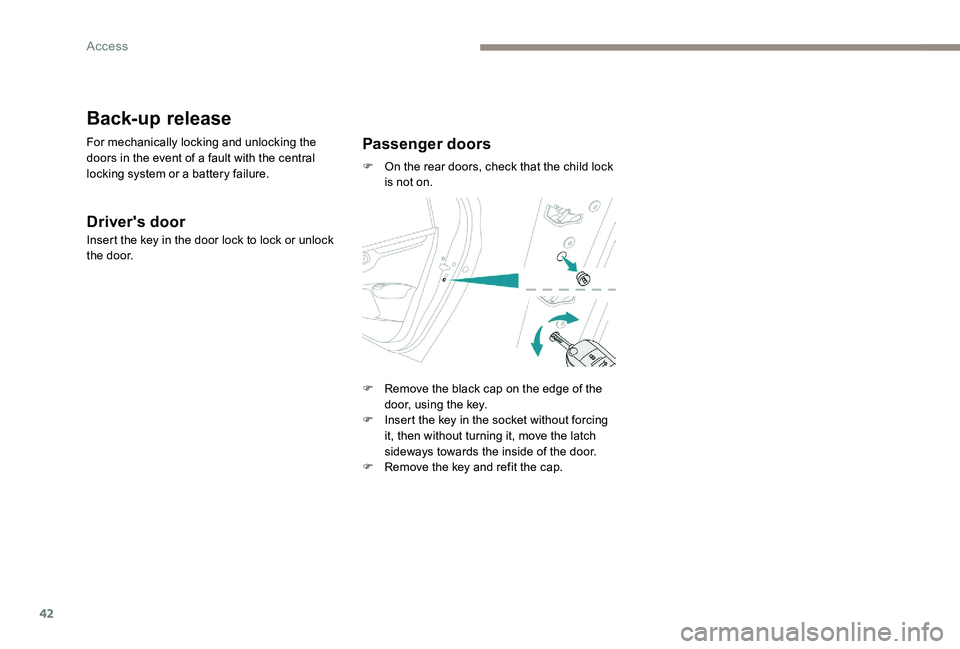
42
Back-up release
For mechanically locking and unlocking the
doors in the event of a fault with the central
locking system or a battery failure.
Driver's door
Insert the key in the door lock to lock or unlock
the door.
Passenger doors
F On the rear doors, check that the child lock is not on.
F
R
emove the black cap on the edge of the
door, using the key.
F
I
nsert the key in the socket without forcing
it, then without turning it, move the latch
sideways towards the inside of the door.
F
R
emove the key and refit the cap.
Access
Page 51 of 306
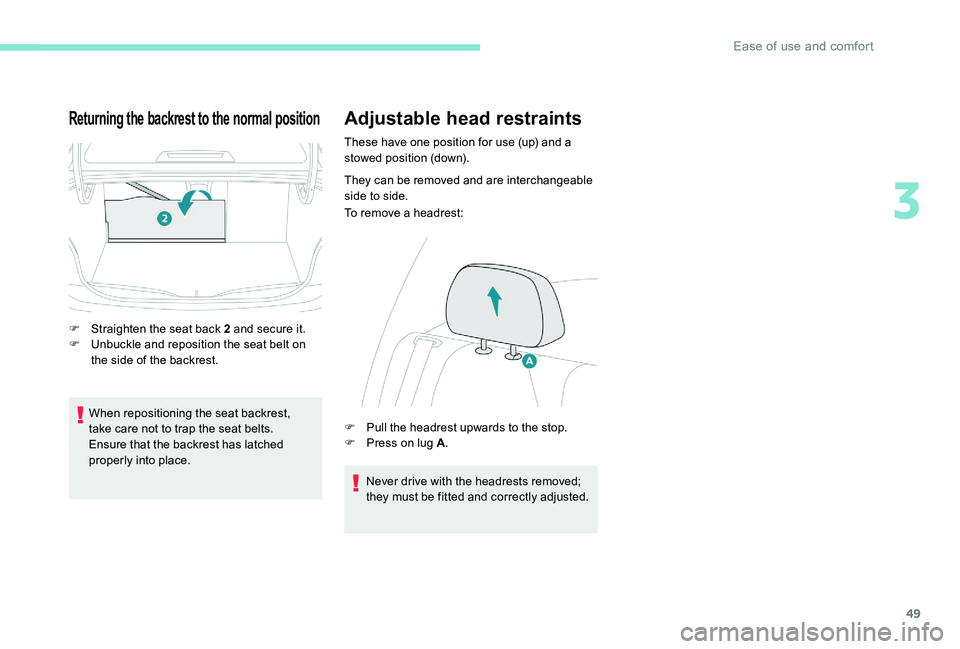
49
Returning the backrest to the normal position
F Straighten the seat back 2 and secure it.
F U nbuckle and reposition the seat belt on
the side of the backrest.
When repositioning the seat backrest,
take care not to trap the seat belts.
Ensure that the backrest has latched
properly into place.
Adjustable head restraints
These have one position for use (up) and a
stowed position (down).
They can be removed and are interchangeable
side to side.
To remove a headrest:
F
P
ull the headrest upwards to the stop.
F
P
ress on lug A .
Never drive with the headrests removed;
they must be fitted and correctly adjusted.
3
Ease of use and comfort
Page 53 of 306
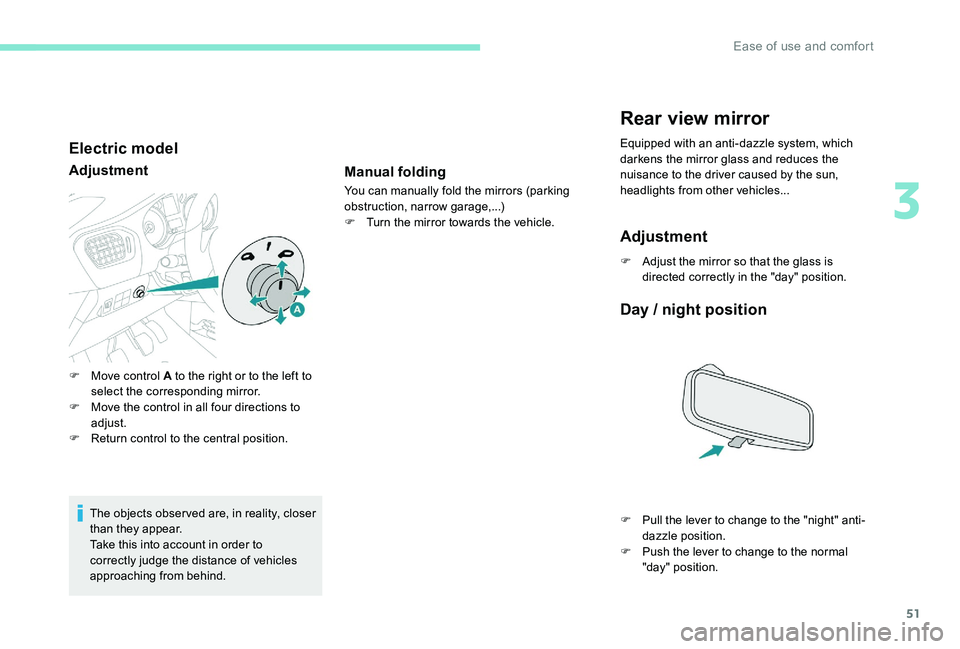
51
Electric model
Adjustment
The objects observed are, in reality, closer
than they appear.
Take this into account in order to
correctly judge the distance of vehicles
approaching from behind.
F
M
ove control A to the right or to the left to
select the corresponding mirror.
F
M
ove the control in all four directions to
adjust.
F
R
eturn control to the central position.
Manual folding
You can manually fold the mirrors (parking
obstruction, narrow garage,...)
F
T
urn the mirror towards the vehicle.
Rear view mirror
Equipped with an anti-dazzle system, which
darkens the mirror glass and reduces the
nuisance to the driver caused by the sun,
headlights from other vehicles...
Adjustment
Day / night position
F Pull the lever to change to the "night" anti-dazzle position.
F
P
ush the lever to change to the normal
"day" position.
F
A
djust the mirror so that the glass is
directed correctly in the "day" position.
3
Ease of use and comfort
Page 57 of 306
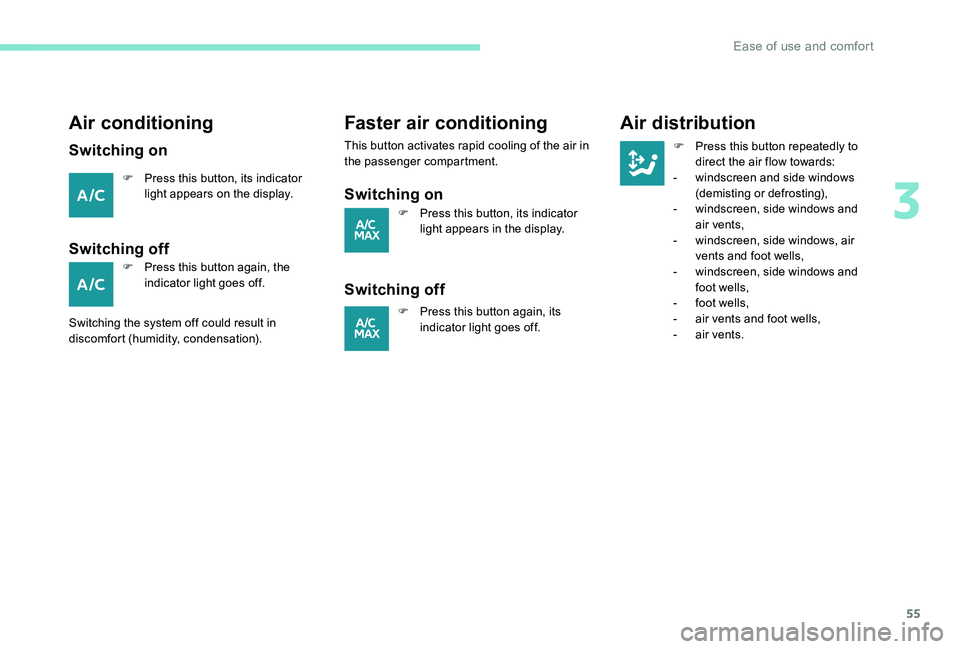
55
Air conditioning
Switching on
F Press this button, its indicator light appears on the display.
Switching off
F Press this button again, the indicator light goes off.
Switching the system off could result in
discomfort (humidity, condensation).
Faster air conditioning
This button activates rapid cooling of the air in
the passenger compartment.
Switching on
F Press this button, its indicator light appears in the display.
Switching off
F Press this button again, its indicator light goes off.
Air distribution
F Press this button repeatedly to direct the air flow towards:
-
w
indscreen and side windows
(demisting or defrosting),
-
w
indscreen, side windows and
air vents,
-
w
indscreen, side windows, air
vents and foot wells,
-
w
indscreen, side windows and
foot wells,
-
f
oot wells,
-
a
ir vents and foot wells,
-
a
ir vents.
3
Ease of use and comfort
Page 61 of 306
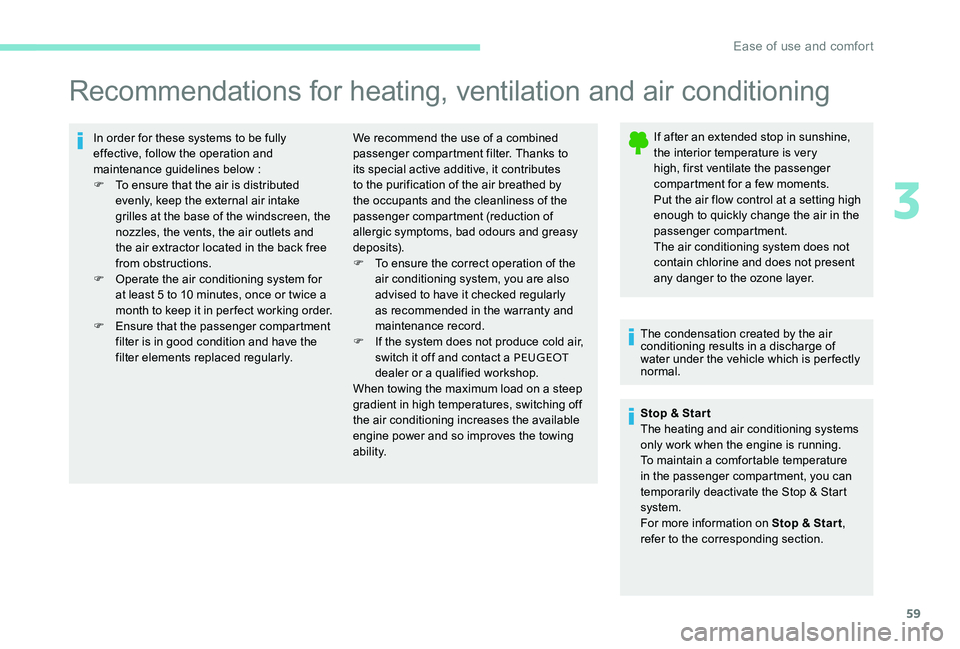
59
Recommendations for heating, ventilation and air conditioning
In order for these systems to be fully
effective, follow the operation and
maintenance guidelines below :
F
T
o ensure that the air is distributed
evenly, keep the external air intake
grilles at the base of the windscreen, the
nozzles, the vents, the air outlets and
the air extractor located in the back free
from obstructions.
F
O
perate the air conditioning system for
at least 5 to 10 minutes, once or twice a
month to keep it in per fect working order.
F
E
nsure that the passenger compartment
filter is in good condition and have the
filter elements replaced regularly. We recommend the use of a combined
passenger compartment filter. Thanks to
its special active additive, it contributes
to the purification of the air breathed by
the occupants and the cleanliness of the
passenger compartment (reduction of
allergic symptoms, bad odours and greasy
deposits).
F
T
o ensure the correct operation of the
air conditioning system, you are also
advised to have it checked regularly
as recommended in the warranty and
maintenance record.
F
I
f the system does not produce cold air,
switch it off and contact a PEUGEOT
dealer or a qualified workshop.
When towing the maximum load on a steep
gradient in high temperatures, switching off
the air conditioning increases the available
engine power and so improves the towing
ability. If after an extended stop in sunshine,
the interior temperature is very
high, first ventilate the passenger
compartment for a few moments.
Put the air flow control at a setting high
enough to quickly change the air in the
passenger compartment.
The air conditioning system does not
contain chlorine and does not present
any danger to the ozone layer.
The condensation created by the air
conditioning results in a discharge of
water under the vehicle which is per fectly
normal.
Stop & Star t
The heating and air conditioning systems
only work when the engine is running.
To maintain a comfortable temperature
in the passenger compartment, you can
temporarily deactivate the Stop & Start
system.
For more information on Stop & Star t ,
refer to the corresponding section.
3
Ease of use and comfort